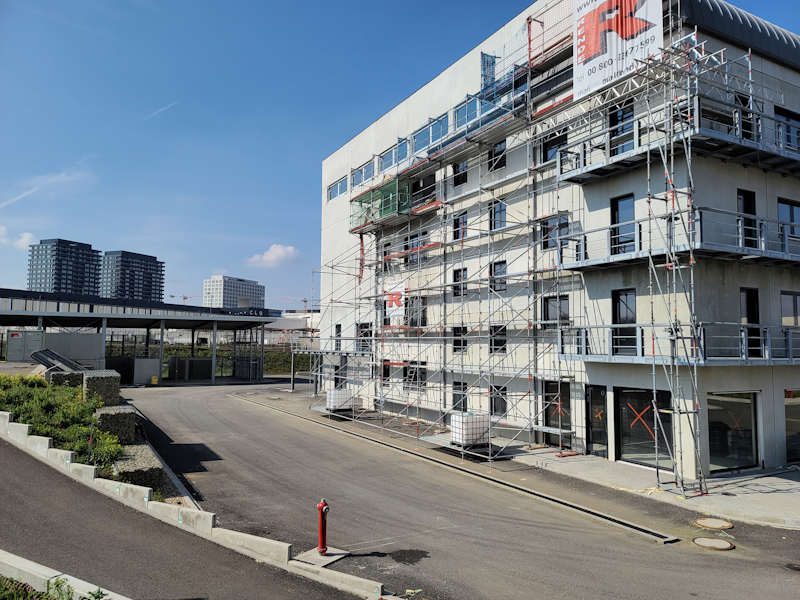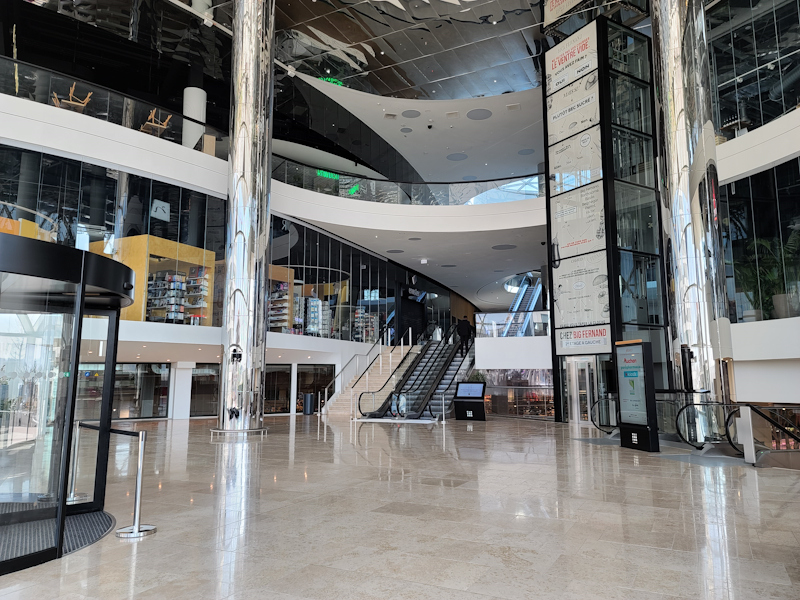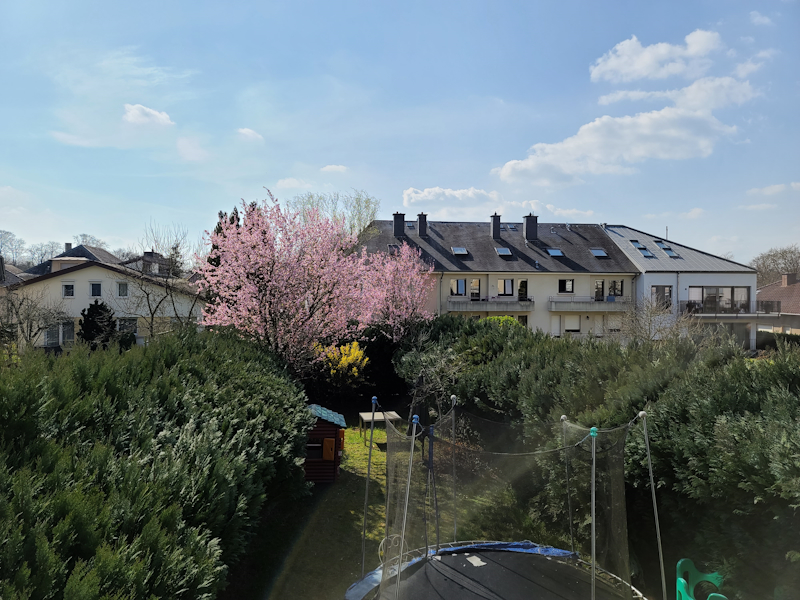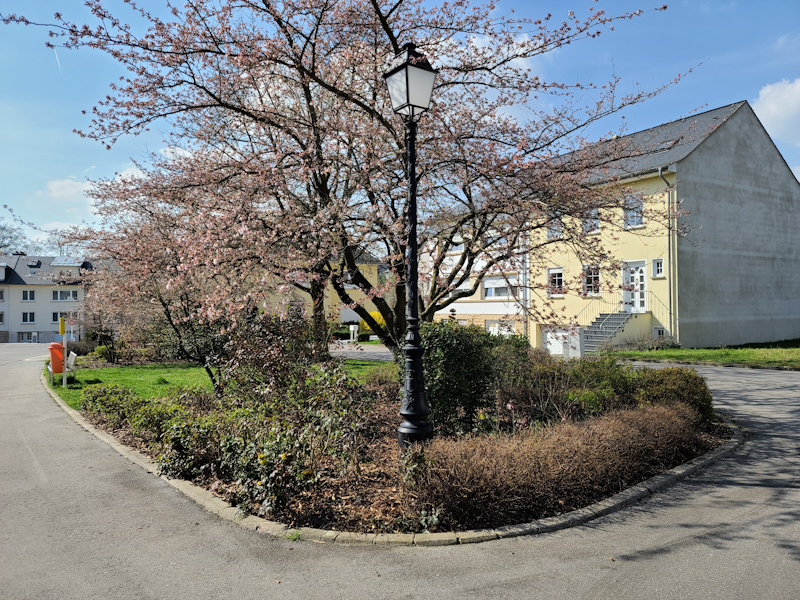The Samsung Galaxy S20+, S20 Ultra Exynos & Snapdragon Review: Megalomania Devices
by Andrei Frumusanu on April 3, 2020 9:30 AM ESTCamera: Daylight Evaluation Continued
I focused on the differences between the S20 devices until now, so let’s take a better look at how they compare against the competition and their predecessors.

[ Galaxy S20U - (S) ]
[ Galaxy S20U - (E) ]
[ Galaxy S20+ (E) ]
[ Galaxy S10+ (S) ] - [ Galaxy S10+ (E) ]
[ iPhone 11 Pro ] - [ Pixel 4 ]
[ Mate 30 Pro ] - [ P30 Pro ]
[ X-T30 ]
On the main camera units, things actually don’t differ all too much in terms of compositions between the different devices. I maybe would have wished for a bit brighter highlights as the phones are again still to shy on those last 10% of levels which didn’t quite convey the sun-lit façade of the building.
The high-light texture retention and sharpening comments made earlier again apply here to both the S20 Ultras. I prefer the Exynos shot as it’s more natural, but it’s a subjective preference choice.
The Ultra-Wide angle is really good in terms of exposure and dynamic range on the S20’s, however I do see the reduction in resolution compared to the S10 as the new phone actually does see a downgrade in the amount of captured details.
I don’t know what’s happening on the Exynos S20 Ultra unit’s Ultra-Wide, but there’s this blob of blurriness in the very center of the image on both phones. It’s as if the phone was trying to do some image fusion with another sensor but failing at it spectacularly. This isn’t present on the S20+.

[ Galaxy S20U - (S) ]
[ Galaxy S20U - (E) ]
[ Galaxy S20+ (E) ]
[ Galaxy S10+ (S) ] - [ Galaxy S10+ (E) ]
[ iPhone 11 Pro ] - [ Pixel 4 ]
[ Mate 30 Pro ] - [ P30 Pro ]
[ X-T30 ]
The S20’s main competition is the iPhone 11, and frankly here they’re losing out to Apple when it comes to the composition of the scene, as the 11 Pro is able to maintain much better dynamic range without clipping the blacks as badly as on the Galaxy phones. In terms of details I also prefer the iPhone as it’s producing a much more natural look. The Snapdragon S20 Ultra’s over-sharpening is again far too much and doesn’t look good, particularly on artificial objects and contours.
The Ultra-Wide here is also a straight down-grade from what we saw on the S10, with lower resolution and worse dynamic range.
Briefly looking at the super-high res images again, it’s as if the two S20 Ultras had completely different sensors as the Snapdragon unit is again far blurrier and feels lower resolution as to what the Exynos is able to achieve. However here it’s the S20+’s 64MP unit which shines as it’s able retain a lot more detail than either Ultra – check out the book shelves on the center-left side.

[ Galaxy S20U - (S) Auto ]
[ Galaxy S20U - (S) Tap ]
[ Galaxy S20U - (E) Auto ]
[ Galaxy S20U - (E) Tap ]
[ Galaxy S20+ (E) Auto ]
[ Galaxy S20+ (E) Tap ]
[ Galaxy S10+ (S) ] - [ Galaxy S10+ (E) ]
[ iPhone 11 Pro ] - [ Pixel 4 ]
[ Mate 30 Pro ] - [ P30 Pro ]
[ X-T30 ]
The S20 phones here had some problems for actually exposing for the foreground of the scene instead of the sky or the actual sun. The S10+E and Pixel 4 are actually amongst the best devices here, but still quite a bit far from the raw dynamic range of the scene (See X-T30 reference). There’s also some severe lens flaring here that wasn’t as prevalent is past devices – again likely due to the larger sensor sizes this year.

[ Galaxy S20U - (S) ] - [ Galaxy S20U - (E) ]
[ Galaxy S20+ (E) ]
[ Galaxy S10+ (S) ] - [ Galaxy S10+ (E) ]
[ iPhone 11 Pro ] - [ Pixel 4 ]
[ Mate 30 Pro ] - [ P30 Pro ] - [ X-T30 ]
Here’s also a scene where I think the new S20’s fail to compete with the iPhone 11 Pro in terms of either detail or dynamic range processing. It’s an upgrade over the S10 series, but I had expected more out of the camera hardware.
These samples also showcase some odd behavior between the Snapdragon and Exynos at 108MP resolution. The latter is just again massively sharper, showing more natural resolution. On the Snapdragon when you closer on the tree branches you see a ton of ghost images. I think what’s happening here is that the phones are taking multiple shots for the HDR compositing, but the Exynos is able to do this in a more optimized way. Also check out the left background buildings on the Snapdragon – it’s a ton sharper and seemingly more in focus, probably a sign that the two phones are focusing on totally different things.

[ Galaxy S20U - (S) ] - [ Galaxy S20U - (E) ]
[ Galaxy S20+ (E) ]
[ Galaxy S10+ (S) ] - [ Galaxy S10+ (E) ]
[ iPhone 11 Pro ] - [ Pixel 4 ]
[ Mate 30 Pro ] - [ P30 Pro ] - [ X-T30 ]
In an indoor shot, the S20 phones also fail to catch up with the iPhone 11. The new phones are certainly upgrades to the S10 series, but I think the dynamic range is a bit lacking and then there’s again the issue of sharpness – over-sharpening on the Snapdragon phone, and the general optics concerns all the models.
Overall Daylight Conclusion – Somewhat Disappointing
The S20 series feel like they’re overpromising and under-delivering on their camera capabilities when it comes to captures. Samsung delivered some incredible hardware here when it comes to the paper specifications, but I feel that it fell short of actually materializing in actual better camera captures.
Starting off with the S20 Ultra: The phone’s telephoto module does deliver on its promises, and the combination of a 4x optical magnification module with a 48MP sensor achieves some incredible zooming capabilities that are clearly far ahead of any other device on the market today. There’s not much more to say here – if you want a phone with an excellent telephoto module, then the S20 Ultra is the obvious choice.
The S20 Ultra’s 108MP main camera was quite unconvincing to me in the daylight shots. There are several layers that we have to peel apart here. First of all, there are very obvious processing differences between the Snapdragon and Exynos models this year. While on the S10 series this was in favor of the Snapdragon, I feel the other way around for the S20 series as the sharpening on the S20 Ultra here has gone absolutely haywire on all the camera’s modules, going beyond what one would consider an improvement of picture quality into the realm of actually being detrimental to the picture. The Exynos variant here seemingly has no sharpening processing at all, and it feels a ton more natural.
On the matter of the 108MP picture shots, there’s also very stark differences between the two variants of the phone, and the Exynos model somehow is consistently ahead in terms of the sharpness and natural resolutions of the shots. I don’t know what the cause for this is, but the two phones clearly are using very different mechanisms to get to the end results.
Lastly and most importantly, I feel like the optics of the modules aren’t able to keep up with the camera sensors. I feared this would happen because of the sensor’s humongous size, and it did show up in the images, and the edges of the picture just aren’t as sharp as on phones with smaller sensors, including the S20+.
The S20 Ultra’s massive quality hole in the 1.1x to 3.9x zoom range is just atrocious. Samsung here severely lags behind Huawei’s processing prowess in actually using the 108MP’s full resolution during the sensor fusion, and particularly shots in the 2x range just look really bad compared to the S20+ and other phones with 2x optical modules. The current software solution of stitching the telephoto module picture into the middle of a digitally magnified 12MP shot just feels like some intern’s implementation. Samsung has the hardware ability to address this, but let’s see on whether they’ll do this.
The Ultra-Wide module also feels like a downgrade compared to the S10 series. I’ve most used this module in daylight settings anyway and I loved the results on the S10 series, and the loss of resolution on the S20’s here is just a negative with essentially no added positives for the new module.
Finally, the S20+’s camera system, at least in daylight, seems like a much more sensible configuration. It doesn’t suffer as badly from the optics on the main sensor, and Samsung’s implementation of the 64MP sensor as a secondary wide-angle resolves the problems of having mediocre intermediary zoom levels. Sure, it doesn’t zoom quite as far and clear as the S20 Ultra, but it’s in line with current 2x optical modules and even slightly outperforms them beyond that, resulting in useable 3-4x shots with plenty of clarity. Ironically enough, I also find that the 64MP shots on the S20+ more often than not actually beats the 108MP shots of the S20 Ultra due to the better optics – although these are not perfect as there’s evident hazing in very high contrast objects.
Frankly, I’m quite disappointed in the results of the S20 series. They’re still good, and represent upgrades to the S10 series in most scenarios, but they fall short of the overhyped expectations. I think Apple’s iPhone 11 Pro’s main sensor quality and pictures are still a step above what the S20’s can deliver in daylight, with cleaner, sharper and more natural results. Huawei also is seemingly years ahead of Samsung when it comes to complex camera systems like the one employed on the S20 Ultra, having much better optics and the proper software processing to actually deal with the multiple modules.










137 Comments
View All Comments
Shadowfax_25 - Friday, April 3, 2020 - link
Excellent article, Andrei. The team over at XDA Developers managed to identify the adb commands which would allow you to set the display to either of the other refresh rates, so I'm sure Samsung could in some way introduce variable refresh rate switching.Here's the article for your perusal: https://www.xda-developers.com/samsung-galaxy-s20-...
Andrei Frumusanu - Friday, April 3, 2020 - link
Yea I saw that. In an ideal case Samsung would actually implement their own pseudo-VRR mode that switches between the display refresh rates based on content.Shadowfax_25 - Friday, April 3, 2020 - link
One more thing: it appears as if the commentary around the speaker evaluation is missing.Shadowfax_25 - Friday, April 3, 2020 - link
Ignore, looks like it was a caching issue on my side.eastcoast_pete - Friday, April 3, 2020 - link
Yes, but that would make sense, and this is Samsung we're talking about here. Still, there's hope, I guess.CecilFitzgerald - Monday, October 12, 2020 - link
Machine learning is in great need now. During the coronavirus period, it would be nice to identify some dependencies and foresee what will happen next in the world. By the way, if you also need to write an essay on machine learning, then i advise you to turn to https://buypapercheap.net/affordable-term-papers-f... which offers writing term papers at affordable prices.yeeeeman - Friday, April 3, 2020 - link
Andrei, amazing review TBH. You have outdone yourself once again and, fie vorba intre noi, cred ca esti succesorul cel mai potrivit pentru Anand. Esti cel mai profi si cand vine vorba de detalii tehnice, dar si de idei interesante de comparatie intre diferite device-uri. Am scris in romana sa nu se supere colegii tai.Please try to add to the energy efficiency table, Ice Lake scores and maybe some energy usages like you have for mobile devices? That would be amazing!
Unashamed_unoriginal_username_x86 - Friday, April 3, 2020 - link
avem traducere Google, tipuleyeeeeman - Friday, April 3, 2020 - link
Tipule, era o glumita. Logic ca poti folosi traducerea.abufrejoval - Saturday, April 4, 2020 - link
Born German with Latin as my first foreign language, and with fluent Spanish and French picked up later, written down Romanian isn't nearly as hard to understand as the spoken language... bine, bine!